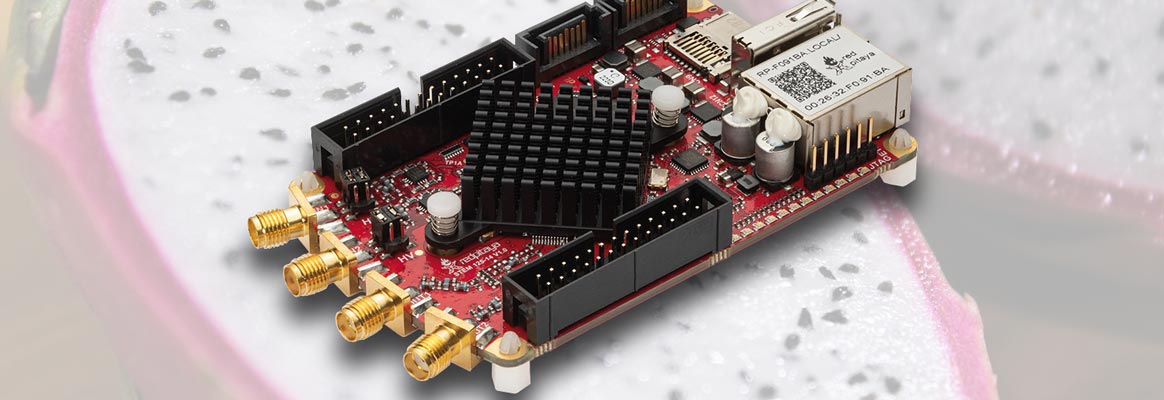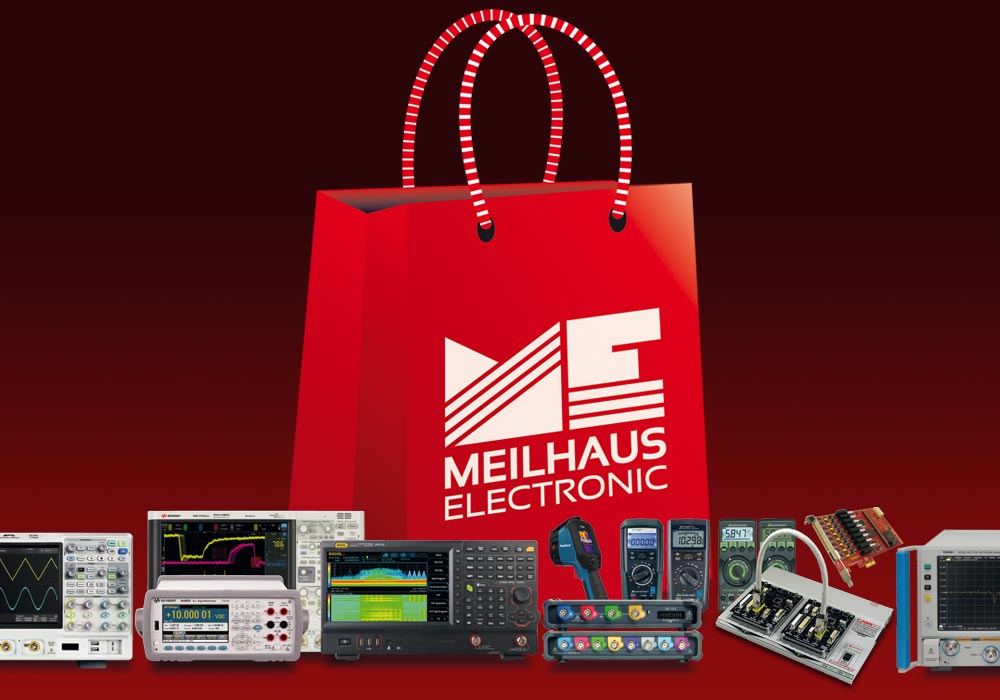Red Pitaya STEMlab 125-14 SoC Measurement and Test Platform

Benefits of the STEMlab 125-14 Embedded T&M Module for RF Applications
- Compact, open, and flexibly programmable.
- Programmable as oscilloscope, signal-generator, spectrum-analyzer, VNA and many more.
- Extensively equipped with I/O and interfaces, including LAN/Ethernet.
Available Kits and Versions
- ▸STEMlab 125-14 Starter Kit (IZD0007).
- ▸STEMlab 125-14 Diagnostic Kit (IZD0005).
- ▸STEMlab 125-14 Ultimate Kit (IZD0008).
- ▸STEMlab 125-14 Calibrated Kit (IZD0004).
- ▸STEMlab 125-14 Low Noise Starter Kit (IZD0030).
- ▸STEMlab 125-14 Z7020 Low Noise Starter Kit (IZD0029).
- ▸STEMlab 125-14 External Clock Starter Kit (IZD0031).
- ▸STEMlab 125-14-4 input 4-Channel Kit (IZD0040).
Red Pitaya STEMlab 125-14 SoC Measurement and Test Platform
The affordable DAQ platform Red Pitaya STEMlab 125-14 is perfect for educational, hobbyist and professional applications where cost optimization is an important factor. The measurement and test module is based on a system-on-a-chip (SoC). It can be operated as an oscilloscope, spectrum-analyzer, LCR-meter or network-analyzer by programming/▸apps. Red Pitaya STEMlab 125-14 is very compact and comes with open-source software. The device has solid performance thanks to 14 bit/125 Msps A/D and D/A converters and a Xilinx Zynq 7010 FPGA. The main advantage is remote accessibility with a WEB app user interface accessible via Ethernet or Wi-Fi.
- Compact SoC measurement and test platform for capturing and generating RF signals.
- Ethernet interface.
- Xilinx SoC (CPU and FPGA).
- Two/four fast analog inputs and two outputs (2-input-channel-model).
- Possibility of integration into own system/product.
- Open software source code available.
- Works with a Linux or Windows PC.
- Can operate as an oscilloscope, signal generator, spectrum, Bode analyzer, logic analyzer, LCR meter (requires optional expansion module), streaming, SDR, or vector network analyzer (requires optional expansion module).
- Can be controlled remotely using LabVIEW, MATLAB, Python, or Scilab.
- Can be reprogrammed according to the user's needs.
- An app marketplace with several free ▸apps is available.
Model Overview
| Model | STEMlab 125-14-2-Channel | STEMlab 125-14-4-Channel |
| Processor | Dual-Core ARM Cortex-A9 MPCore | Dual-Core ARM Cortex-A9 |
| FPGA | Xilinx Zynq 7010 | Xilinx Zynq 7020 SOC |
| RAM | 512 MB (4 Gb) | 512 MB (4 Gb) |
| System memory | Micro-SD up to 32 GB | Micro-SD up to 32 GB |
| Interfaces | Ethernet 1 Gbit USB 2.0 Wi-Fi using optional Wi-Fi dongle |
Ethernet 1 Gbit USB 2.0 Wi-Fi using optional Wi-Fi-Dongle |
| RF inputs | ||
| Channels | 2 | 4 |
| Sample rate | 125 MS/s | 125 MS/s |
| ADC resolution | 14 bit | 14 bit |
| Full scale voltage range | ±1 V/±20 V | ±1 V/±20 V |
| Input coupling | DC | DC |
| Bandwidth | DC...60 MHz | DC...60 MHz |
| Input impedance | 1 MΩ | 1 MΩ |
| RS outputs | ||
| Channels | 2 | - |
| Sample rate | 125 MS/s | - |
| DAC resolution | 14 bit | - |
| Full scale voltage range | ±1 V | - |
| Load impedance | 50Ω | - |
| Shortcut protection | Yes | - |
| Typical rising/falling time | 2 V/10 ns | - |
| Bandwidth | DC...50 MHz | - |
| Extension connector | ||
| Digital I/Os | 16 | 20 |
| Analog inputs | 4 channels, 0...3.5 V, 12 bit | 4 channels, 0...3.5 V, 12 bit |
| Analog outputs | 4 channels, 0...1.8 V, 12 bit | 4 channels, 0...1.8 V, 12 bit |
| Communication interfaces | I2C, UART, SPI | I2C, UART, SPI |
| Available voltages | +5 V, +3.3 V, -4 V | +5 V, +3.3 V, -4 V |
| Synchronization | Trigger input through extension connector; daisy chain connection over SATA connection | Trigger input through extension connector; daisy chain connection over SATA connection |
Comparing the Kits
| Functions and apps | STEMlab 125-14 | ||||||
| Kits | Starter (IZD0007) |
Diagnostic (IZD0005) |
Ultimate (IZD0008) |
Calibrated (IZD0004) |
Low Noise Starter (IZD0030) |
Z7020 Low Noise Starter (IZD0029) |
External Clock Starter (IZD0031) |
| Oscilloscope1) | ✓ | ✓ | ✓ | ✓ | ✓ | ✓ | ✓ |
| Signal generator1) | ✓ | ✓ | ✓ | ✓ | ✓ | ✓ | ✓ |
| Spectrum analyzer1) | ✓ | ✓ | ✓ | ✓ | ✓ | ✓ | ✓ |
| Bode analyzer1) | ✓ | ✓ | ✓ | ✓ | ✓ | ✓ | ✓ |
| Logic analyer1) | (✓) | ✓ | ✓ | ✓ | (✓) | (✓) | (✓) |
| LCR meter1) | (✓) | (✓) | ✓ | (✓) | (✓) | (✓) | (✓) |
| VNA1) | (✓) | (✓) | (✓) | (✓) | (✓) | (✓) | (✓) |
| Sensor extension | (✓) | (✓) | (✓) | (✓) | (✓) | (✓) | (✓) |
| Streaming | ✓ | ✓ | ✓ | ✓ | ✓ | ✓ | ✓ |
| SDR | ✓ | ✓ | ✓ | ✓ | ✓ | ✓ | ✓ |
| SCPI server (MATLAB, LabVIEW, Python) | ✓ | ✓ | ✓ | ✓ | ✓ | ✓ | ✓ |
| Jupyter notebook (Python) | ✓ | ✓ | ✓ | ✓ | ✓ | ✓ | ✓ |
| Included in the kits | Starter (IZD0007) |
Diagnostic (IZD0005) |
Ultimate (IZD0008) |
Calibrated (IZD0004) |
Low Noise Starter (IZD0030) |
Z7020 Low Noise Starter (IZD0029) |
External Clock Starter (IZD0031) |
| Module | STEMlab 125-14 | ||||||
| Power supply | ✓ 5 V/2 A | ✓ 5 V/2 A | ✓ 5 V/2 A | ✓ 5 V/2 A | ✓ 5 V/2 A | ✓ 5 V/2 A | ✓ 5 V/2 A |
| Ethernet cable | ✓ 1 m | ✓ 1 m | ✓ 1 m | ✓ 1 m | ✓ 1 m | ✓ 1 m | ✓ 1 m |
| SD card | ✓ 16 GB | ✓ 16 GB | ✓ 16 GB | ✓ 16 GB | ✓ 16 GB | ✓ 16 GB | ✓ 16 GB |
| Acryl housing | - | - | - | - | - | - | - |
| Aluminum housing | - | ✓ | ✓ | ✓ | - | - | - |
| Wi-Fi dongle | - | ✓ | ✓ | ✓ | - | - | - |
| Oscilloscope probes | - | ✓ 2x | ✓ 2x | ✓ 2x | - | - | - |
| Logic analyzer probes | - | - | - | - | - | - | - |
| Logic analyzer cable | - | - | - | - | - | - | - |
| Logic analyzer extension module | - | ✓ | ✓ | ✓ | - | - | - |
| SMA-to-BNC adaptor | - | ✓ | ✓ | ✓ | - | - | - |
| 50-Ω termination | - | ✓ | ✓ | ✓ | - | - | - |
| SMA T adaptor | - | ✓ | ✓ | ✓ | - | - | - |
| LCR meter module | - | - | ✓ | - | - | - | - |
| Sensor extension module | - | - | - | - | - | - | - |
1) The software apps are free. To use them with the Red Pitaya modules additional hardware options are required, depending on the app (logic analyzer, LCR meter, VNA). Depending on the kit version they are included in the kits or available as optional accessories.
Continue with the Kits...
- ▸STEMlab 125-14 Starter (IZD0007).
- ▸STEMlab 125-14 Diagnostic (IZD0005).
- ▸STEMlab 125-14 Ultimate (IZD0008).
- ▸STEMlab 125-14 Calibrated (IZD0004).
- ▸STEMlab 125-14 Low Noise Starter (IZD0030).
- ▸STEMlab 125-14 Z7020 Low Noise Starter (IZD0029).
- ▸STEMlab 125-14 External Clock Starter (IZD0031).
- ▸STEMlab 125-14-4 4-Channel Kit (IZD0040).
Frequently Asked Questions:
Question: What does SoC mean?
Answer: SoC stands for "System on a Chip". It describes the integration of the largest part of a system (in this case an RF measurement system) into one chip. This joining of many functions in one chip has the advantages of lower energy consumption, miniaturization of the system and overall cost savings. In the case of the Red Pitaya, the system consists of a dual-core ARM Cortex-A9 MPCore processor and a Xilinx Zynq 7010 or 7020 FPGA. The hardware provides the basis for an RF measurement system (four or two analog inputs and two analog outputs, 16 digital channels). The functionality is determined by the programming or already available software apps. Thus, the Red Pitaya system can work as a 2-channel oscilloscope, 2-channel signal generator, logic-, spectrum-, Bode-, vector-network-analyzer (VNA), and LCR meter (expansion options are required for some of the functions).
Question: What exactly do I get when I order a Red Pitaya board?
Answer: Red Pitaya boards are offered in packages/bundles ("kits"). Depending on the version, they contain a Red Pitaya board and accessories. In the basic case, the accessories consist of an SD card, a power supply and an Ethernet cable. The "larger" packages include, for example, enclosures, probes and other connection accessories (see table above). Red Pitaya is an open source system. It can therefore be programmed by the user - even at the FPGA level. In addition, a number of free apps are available. You can find an overview ▸here.







































